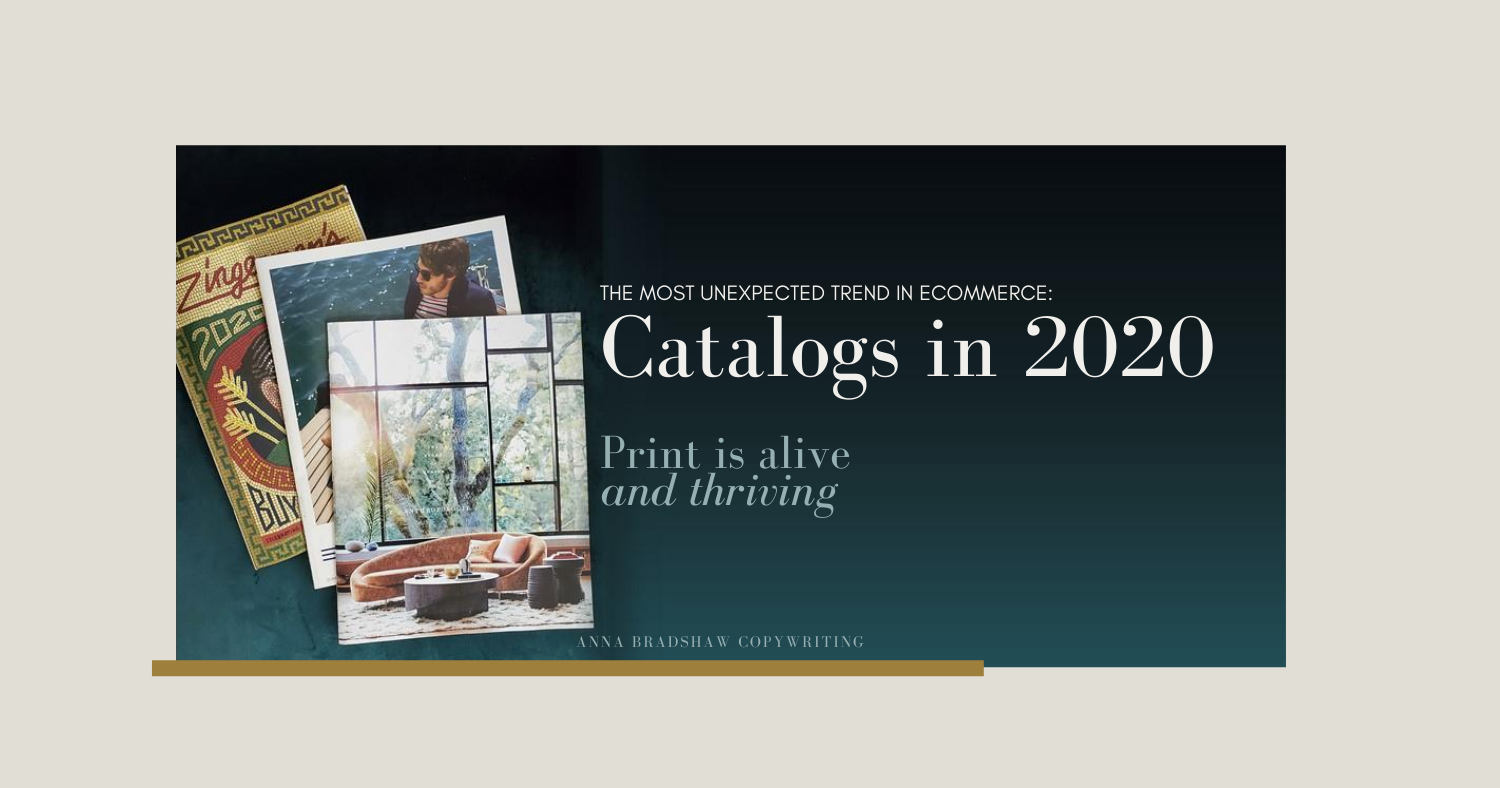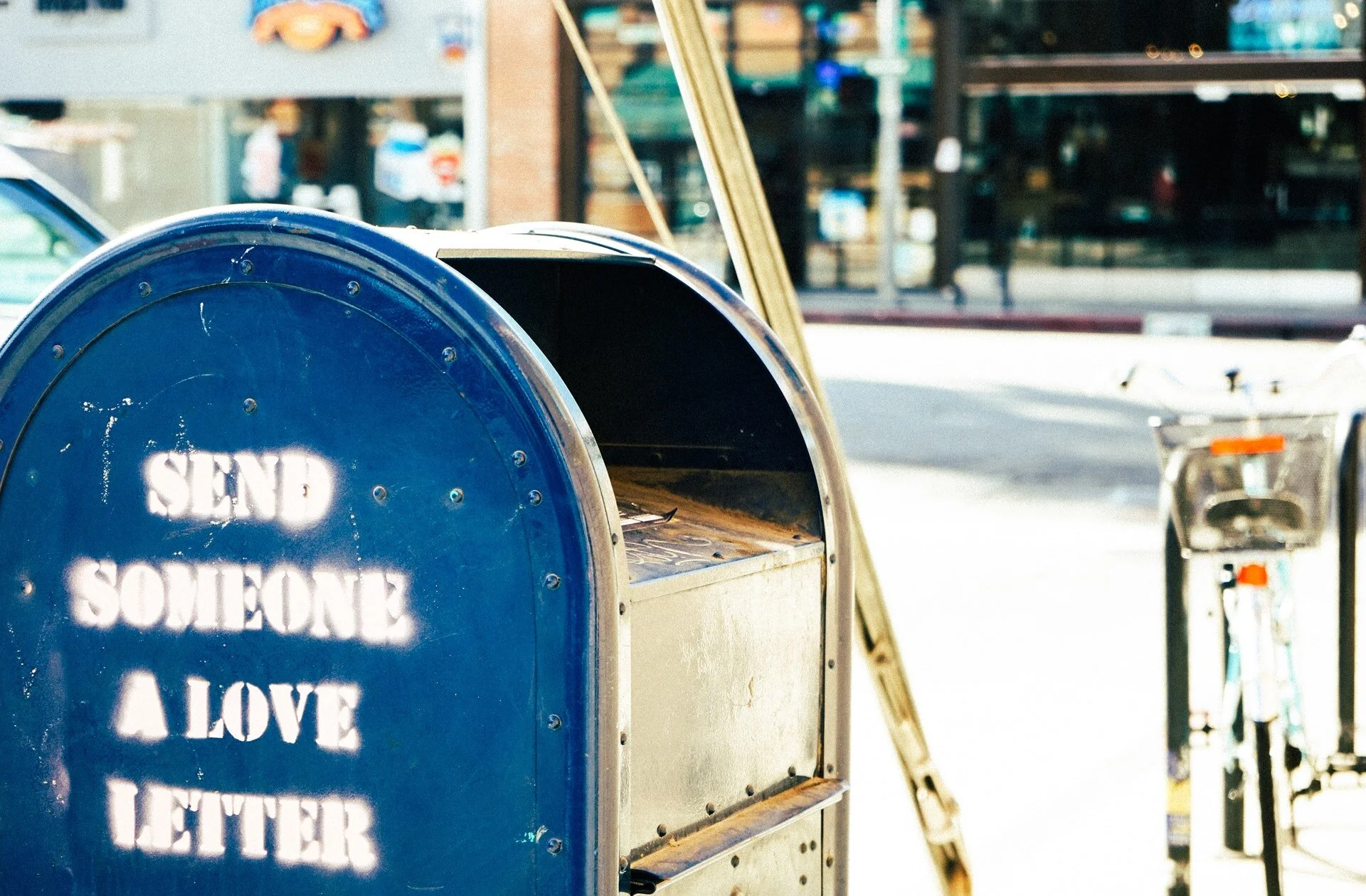Explore the Blog
Editorial Newsletters: Does Your Brand Actually Need One?
Popular reads
The Problem With Using AI For Content Writing in 2025
Recent Searches
Content Marketing, Copywriting, Email Marketing, Expert Interviews, Website Copywriting, eCommerce Marketing, B2B Marketing
Get the inside scoop on digital marketing for food and beauty brands
Catalog Marketing is the Newest Trend in Ecommerce

Editor’s note: The 2025 Amazon toy catalog is landing in inboxes this week, making it the perfect time to revisit the topic of real, paper catalogs in a digital world.
Digital brands are bringing print catalogs back to life – and getting great results.
Fannie packs aren’t the only “those-are-never-coming-come-back” thing that’s officially back in style.
Print catalogs are cool again. Yes, that kind of catalog – the booklet with photos of your merchandise along with descriptions – the kind that’s printed on real paper and delivered by the USPS.
In fact, a print catalog may just be the smartest way for digital startups to reach consumers in 2020.
Digital advertising has been trending for the past two decades. But here are four good reasons why entrepreneurs are starting to revisit print.
1. They work …even with shoppers used to purchasing online
Jonathan Zhang of the University of Colorado worked with an ecommerce jewelry company to study whether print catalogs could amplify email marketing efforts and increase ROI.
The experiment worked:
-
The segment of customers who received both email and catalog campaigns had a 15% increase in sales compared to customers who received only emails.
-
The segment of customers who received both email and catalog campaigns had a 49% increase in sales compared to the control group who received neither.
-
The segment of customers who received emails, but not catalogs, had a 28% increase in sales compared to the control group who received neither.
-
Of customers who received catalogs and inquired about products, over 90% reported having kept them in their home for around a week.
After considering the costs of distributing catalogs, the ROI was still 600%.
Likewise, Bonobos found that customers who received print catalogs spend 150% as much as shoppers who didn’t.

Photo by Kaboompics .com from Pexels
2. The least crowded space: your customer’s mailbox
As marketers shift their attention, and dollars, to digital, they’re creating more space to stand out and get attention in mailboxes.
Between 2006 and 2017, marketing mail declined by 24% (not to mention the 40% decline in first class mail, much of which was marketing-related)
Whereas countertops across America used to be piled with catalogs every week, now yours will likely have little competition for attention on the walk back from the mailbox.

Photo by Jaymentri from Pexels
3. Digital has stolen the joy of browsing
When you’re selling online, customers lose the tactile experience of handling your products before buying.
Whereas physical stores have a host of ways to create a brand experience, digital selling strips away a lot of those elements, paring the buying experience down to the bare minimum, making it predictable, reliable and easy-to-navigate.
But print gives you a way to re-create a piece of that tactile experience.
Consider Anthropologie. Walking into their physical store is like stepping into a bohemian spa – all the senses are immediately engaged with scented candles, music, textured floorboards, and colorful displays. But shopping on Anthropologie’s website gives you pretty much the same experience as shopping on other website.
Browsing their catalog helps bridge the gap: thick matte paper creates a sense of modern restraint, while editorial photography elevates the clothing and narrative copy creates a storyline.
The brand’s clothing style may be consistent online, but it becomes a lifestyle when you see it play out on paper.

Anthropologie catalogs are known for their high-quality photography.
Cuyana co-founder Shilpa Shah said of the company’s quarterly print catalog “We designed it to story-tell; it’s very beautiful to look at, and shopping is a secondary part of the experience.”
Think through which brand elements set you apart in the marketplace, and ways you might translate those qualities into paper.
Chances are, you’ll feel a lot more creative freedom on paper, than you do online.
4. Catalogs tap into emotion
Unlike baby boomers and even gen-Xers who grew up viewing catalogs as junk mail, younger millennials see catalogs as more of a novelty.
Most millennials are old enough to remember flipping through Sears catalog toy section, or savoring the pages of American Girl’s latest issue, dog earring and circling wish list requests.
Your brand can harness the well-documented power of nostalgia (or “newstalgia“) with print catalogs.
When Jeni’s launched their holiday ice cream catalog for 2019, they tapped into this feeling on Facebook: “Remember that feeling when the toy catalog arrived and you’d tear it open and madly circle all the things that you wanted? All that joy and anticipation. It’s time to reclaim that magic—our splendid holiday catalog is HERE! Trust us when we say this one is a page-turner packed with gift ideas for everyone on your list…”
When customers in Zhang’s experiment were surveyed, the researchers found that catalog descriptions rated as more impactful than the very same text and photos conveyed via email!
Zhang wrote that on a scale of 1-7, “those in the email-only group gave an average rating of 4.3, whereas those in the catalog condition gave a rating of 5.6, and the difference is statistically significant. These results provide evidence that catalogs can increase sales and consumer engagements through enhanced product vividness and the ease of product imagination.”
So not only are catalog recipients getting the discovery path of browsing, but that browsing is more vivid in print, than digital.
5. Catalogs let your merge content & commerce
Content marketing isn’t going anywhere. And because of the low barrier to entry, most content is pushed out online.
A few brands have created print content arms – Sir Kensington’s, Away luggage, and AirBNB all have their own magazines. But launching an entirely new magazine is a big investment.
Catalogs let you bridge the gap and test content marketing in print.
Zingerman’s “mail order” processes hundreds of online orders every week, but still sends a print catalog to customers. Selling more-expensive-than-usual items often requires customer education. You’ve got to explain why your prices are worth it.
So Zingerman’s catalog blends well-written articles into its catalog pages for a seamless and enjoyable browsing experience.

Zingerman’s places product education right next to product descriptions
Catalogs also let you bring the customer a bit closer to your brand. Saint James adds behind the scenes photos to share the story of their shirts. Behind-the-scenes glimpses help consumers feel more connected to your brand, and more proud of their purchases once they arrive.

Saint James gives a peek at the making of their famous breton tops
Jeni Britton Bauer of Jeni’s sees print catalogs as a key storytelling element that fits with her brand’s ecommerce arm. As she shared on a podcast “…it’s this whole storytelling through ice cream, which makes just such a beautiful gift. And so we’ve got this beautiful box where you UN-box it and that’s where the catalog comes in. It’s been really fun and we’ve been doing this since 2004 shipping ice cream across the country.”

Photo from Jenis.com
Bonus: Catalogs show that your digital-native brand is legit
Because they’ve typically been the domain of traditional retailers like Nordstrom, Eddie Bauer, and Pottery Barn, glossy catalogs also bring a level of credibility to DTC retailers.
In fact, more and more digital-native brands like Modcloth, ThirdLove, Huckberry, and Ledbury are starting to turn to catalogs.
Consider using catalogs as a showroom for your online store – a way to introduce your brand in a new format, and highlight your top sellers.

Photo from Huckberry.com
Not every catalog business is ecommerce… even in 2025
This year, Outline, a multi-brand apparel shop in Brooklyn, New York, created its first print catalog after taking down its ecommerce presence last year. Just because it feels like a business has to have a robust online platform to compete these days, doesn’t mean that’s necessarily true! Outline shoppers can make in person appointments, but they can also email and DM to order the items they spy in the catalog.

Photo from Outline’s Instagram account
Direct mail marketing for a new age
Of course, responsible catalog mailing looks different in 2020 than it did a couple decades ago.
Consumers are increasingly aware of waste in retail, whether through packaging or marketing materials.
But that doesn’t mean you necessarily have to go paperless. Smart founders are following the example of companies like Patagonia, which in 2014 made thedecision to use 100% post-consumer recycled paper for its catalogs.
Just because you only sell online, doesn’t mean you can’t showcase your wares, build credibility, and spread awareness through print.
Takeaway: If you’re tired of seeing lower returns on social media ads, and seeing your emails sink into the abyss of the Promotions tab, then consider going old-school with a real life, paper catalog. Direct mail marketing strategies might just be the biggest new trend in ecommerce.
Contact me to discuss ecommerce catalog copywriting services today.
Top 2025 Content Marketing Trends
This year, I’m seeing three big trends come to the forefront of content marketing.
a must-read
Follow along on instagram
Not Ready to Work Together Quite Yet?
Stay in touch with the Your Brand Editor newsletter 📬
Anna Bradshaw is a copywriter and content strategist based outside Raleigh, North Carolina. She focuses on creating brand marketing campaigns, evergreen SEO content plans, and website copy that converts.